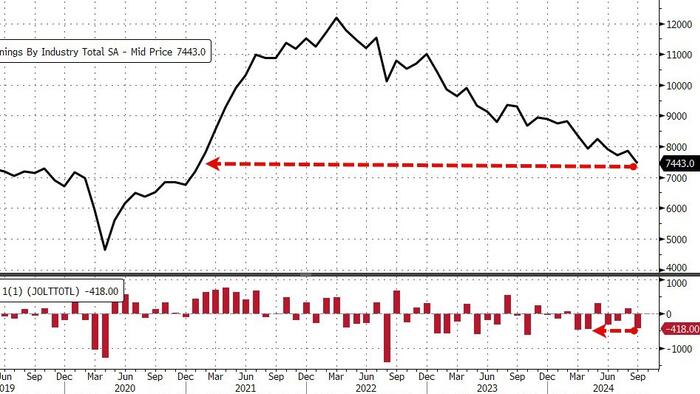In recent discussions surrounding employment statistics, a notable shift has occurred in the last month concerning the number of job openings in the United States, particularly reflecting the political climate and public perception of economic indicators. Initially, in August, despite ongoing skepticism about the administration’s performance, the Bureau of Labor Statistics (BLS) reported a surprising increase in job openings from a revised figure of 7.7 million to 8.04 million, significantly surpassing Wall Street’s expectations. This positive assessment, however, seemed closely tied to the political prospects of Kamala Harris in the electoral race at that time. Contrasting that moment of apparent optimism, the latest data released in September paints a starkly different picture, revealing a dramatic plunge in job openings to 7.4 million—the lowest level since early 2021. This sudden decline marks a 418,000 decrease and falls well short of economic forecasts, arising amidst a climate of political uncertainty.
The implications of this statistical turn are troubling, especially considering the adjustments made to previous reports. The BLS revised August’s impressive job openings figure downward from 8.04 million to 7.861 million. This trend of revising positive employment data downward raises skepticism about the reliability of these statistics. The revisions and the drop in job openings, noted as a staggering 6-sigma miss, lead to questions surrounding the actual health of the job market. According to the BLS breakdown, the most significant drops in job openings occurred within health care and social assistance, along with government sectors, contrasting with increases in finance and insurance. This disparity reflects not only job availability trends across sectors but also highlights ongoing challenges within specific industries, indicating broader economic implications.
The narrative surrounding these employment statistics has been further complicated by earlier claims about job openings within the construction sector. Marked previously by an unexpected surge in openings during a period of stagnation in the housing market due to elevated interest rates, the BLS has since recalibrated these figures downward. Such adjustments hint at potential manipulation or miscalculation in the reporting process, fostering skepticism among analysts and the public alike. Critiques aimed at the integrity of employment data become paramount in viewing the broader economic landscape. With construction job openings dropping again, the uncertainty grows over future employment trends, particularly as political dynamics shift and new administrations emerge.
The overarching state of the job market remains complex. Although the number of hires rose by 123,000 to reach 5.558 million—technically exceeding post-COVID lows—the number of worker quits experienced a significant decline to 3.071 million, marking a new low since the pandemic’s onset. This contraction in quits indicates growing employee hesitance to leave jobs amidst perceived instability in the job market. The trends observed in employment, particularly reductions in voluntary separations, signal a stagnant labor environment reminiscent of pre-recovery periods, suggesting a potential return to conditions seen several years prior when economic growth was notably slower.
An essential aspect of this data discussion lies in acknowledging the limitations and reliability of the reported statistics. A significant portion of job openings is based on estimation, with the BLS itself admitting that more than two-thirds of final job opening figures derive from guesswork rather than concrete responses. The low response rate from businesses participating in the Job Openings and Labor Turnover Survey (JOLTS)—hovering around a mere 33%—underscores the tenuous nature of these statistics. Given such shortcomings, policy decisions and economic forecasts based on these data may carry inherent risks, as they do not fully capture the real employment landscape.
Ultimately, as the political situation continues to unfold and perceptions of the economy remain in flux, it is crucial to critically evaluate the veracity and implications of labor statistics. The sharp fluctuations in reported job openings and adjustments to previous data create an environment of uncertainty and skepticism about the actual health of the job market. As stakeholders reflect on this data landscape, it becomes imperative to demand transparency in employment reporting, alongside a broader understanding of economic conditions and trends. The ongoing discourse around these statistics will likely influence public trust and shape future economic policies, especially as the political implications of employment data continue to resonate across the nation’s economic framework.

